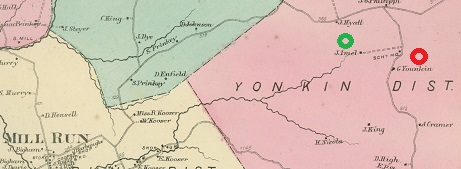
|
George A. Younkin (1833-1913) and |
 |
Imel Cemetery |
George A. Younkin and Charlotta (Younkin) Younkin were first cousins who married each other.
George (1833-1913) was born on March 10, 1833 (or 1834) in Turkeyfoot Township, the son of George and Nancy (Johnson) Younkin. Charlotta "Lottie" (1827-1898) was born on Oct. 18, 1827 in or near Clay Run, Fayette County., the daughter of Charles and Jane (Johnston) Younkin.
The couple was wed in Normalville, Fayette County on Nov. 12, 1854. Justice of the peace James Critchfield officiated. At the time, George was age 21 and Charlotta 27.
They had two sons, William "Dayton" Younkin and James "Dempsey" Younkin.
George did not move to Greene County, PA with his parents and younger siblings in the 1850s, but remained in and around the Somerset/Fayette County border area for the rest of his life. As a young adult, he stood five feet, eight inches tall, and had a dark complexion, hazel eyes and dark hair. Friend Joseph King once wrote that "I have known [George] since he was a boy & know that prior to his enlistment he was a strong & healthy man...."
He served in the Civil War as a private with the 97th Pennsylvania Infantry, Company A, perhaps also known as the 15th Pennsylvania Volunteer Infantry. He enlisted in 1864 and served for a term of nine months before his discharge. His regiment was sent south the North Carolina.
While on a march from Wilmington to Goldsboro and Raleigh, NC, in late March or early April 1865, George went missing. Recalled his longtime friend and fellow soldier John W. Seneff, "we were camped near Ralleigh some days before he made his Appearance, and when he cam up he looked bad, was lame, and had a bad running off of the bowels, he had left his overcoat, Blankets and all his equipments, in the line of clothes on the way, and by that means would be much exposed in the cool of the nights.... I looked after him, gave him a blanket and Sar[geant] Black gave him one & so we had him sheltered...."
|
|
| Union troops march past abandoned Confederate earthworks in Wilmington on their way to Goldsboro, North Carolina |
Another neighbor and tent-mate, William Ott, wrote that:
...on a heavy march ... I saw George A. Yonkin so stiffened up with what he sed was rheumatism so they had to carry him away on strechers. he appeard to suffer grate pane even wen moved. He did not come to the company for som time after and appeard to be stiff and could not handle himself as a solder aught to do.
After the war, George returned home to Mill Run. He was a longtime farmer in the Mill Run and Clay Run area.
George was mentioned in a June 1901 article about his brother Jeremiah in the Connellsville Courier newspaper. The story said that Jeremiah, now living in Iowa, had not been back to Connellsville in 15 years, and scarcely knew the town. It reported that Jeremiah "is a brother of George Younkin of Connellsville.
In 1890, a special census count was made of Civil War veterans in the United States, George was listed as living in Elm (Normalville) and disclosed that he was afflicted with "Rheumatism." He also complained to friends of ongoing diarrhea, hemorrhoids, kidney pain and headaches. At some point, he also fractured his breast bone.
|
|
| 1875 Atlas of Fayette County showing George's farm (red dot) in the "Yonkin District" east of Mill Run, and the nearby farm of his first cousin by marriage, John Imel (green dot), where the Imel Cemetery is now located |
Lottie suffered for many years with consumption (today known as tuberculosis). She died of its effects as she neared her 70th birthday in September 1898. The Connellsville Daily Courier said "The husband and friends have the sympathy of this community." Rev. John W. Gallentine preached the funeral sermon and officiated at her burial in Imel Cemetery.
After George retired, he sold the 186-acre family farm to his grandson-in-law, Jacob A. Shroyer in about 1901. He then moved into the Snydertown section of Connellsville. Under the terms of the sale, Jacob made an $800 down payment with the promise to pay $200 each year for the next 10 years.
On Feb. 1, 1913, at the age of 81, George "was in good health and ... made two trips down town," noted the Weekly Courier. But later in the day, he was felled by a stroke of paralysis and never recovered. He suffered for a few days and died on Feb. 3, 1913, at home. His remains were shipped to Mill Run and thence moved to the old homestead, now occupied by his married granddaughter Laura Belle Shroyer for funeral services. Burial followed in Imel Cemetery.
Copyright © 2013, 2016-2017 Mark A. Miner |
Research for this page
graciously shared by the late Olive (Rowan) Duff and the late Donna (Younkin)
Logan. |

